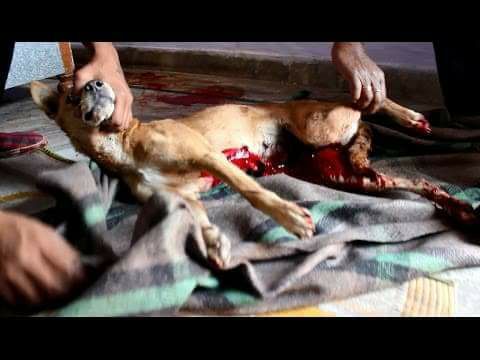What To Do If Your Pet Is Found Bleeding?
Bleeding pets often suffer blood loss as a result of trauma. If bleeding is severe or continuous, the animal may lose enough blood to cause shock (loss of as little as 2 teaspoons per pound of body weight may cause shock). Emergencies may arise that require the owner to control the bleeding, even if it is just during transport of the animal to the veterinary facility. Pet owners should know how to stop hemorrhage (bleeding) if their pet is injured.
Techniques to stop external bleeding:-
The following techniques are listed in order of preference.
1) Direct pressure:--gently press a compress (a pad of clean cloth or gauze) over the bleeding absorbing the blood and allowing it to clot. Do not disturb blood clots after they have formed. If blood soaks through, do not remove the pad; simply add additional layers of cloth and continue the direct pressure more evenly. The compress can be bound in place using bandage material which frees the hands of the first provider for other emergency actions. In the absence of a compress, a bare hand or finger can be used. Direct pressure on a wound is the most preferable way to stop bleeding.
2) Elevation:--if there is a severely bleeding wound on the foot or leg, gently elevate the leg so that the wound is above the level of the heart. Elevation uses the force of gravity to help reduce blood pressure in the injured area, slowing the bleeding. Elevation is most effective in larger animals with longer limbs where greater distances from wound to heart are possible. Direct pressure with compresses should also be maintained to maximize the use of elevation. Elevation of a limb combined with direct pressure is an effective way to stop bleeding.
3) Pressure on the supplying artery:-- if external bleeding continues following the use of direct pressure and elevation, finger or thumb pressure over the main artery to the wound is needed. Apply pressure to the femoral artery in the groin for severe bleeding of a rear leg; to the brachial artery in the inside part of the upper front leg for bleeding of a front leg; or to the caudal artery at the base of the tail if the wound is on the tail. Continue application of direct pressure.
4) Pressure above and below the bleeding wound:-- this can also be used in conjunction with direct pressure. Pressure above the wound will help control arterial bleeding. Pressure below the wound will help control bleeding from veins.
5) Tourniquet:--use of a tourniquet is dangerous and it should be used only for a severe, life-threatening hemorrhage in a limb (leg or tail) not expected to be saved. A wide (2-inch or more) piece of cloth should be used to wrap around the limb twice and tied into a knot. A short stick or similar object is then tied into the knot as well. Twist the stick to tighten the tourniquet until the bleeding stops. Secure the stick in place with another piece of cloth and make a written note of the time it was applied. Loosen the tourniquet for 15 to 20 seconds every 20 minutes. Remember this is dangerous and will likely result in disability or amputation. Use of a tourniquet should only be employed as a last-resort, life-saving measure!
6) Internal bleeding:--internal bleeding is a life-threatening condition, but it is not obvious like external bleeding. Any bleeding which is visible is external.
Internal bleeding occurs inside the body and will not be seen. There are, however, external signs of internal bleeding:
• the pet is pale (check the gums or eyelids).
• the pet is cool on the legs, ears, or tail.
• the pet is extremely excited or unusually subdued. If any of these signs are evident, the pet should be immediately transported to a veterinary facility for professional help. Remember: internal bleeding is not visible on the outside.



+1.svg)
